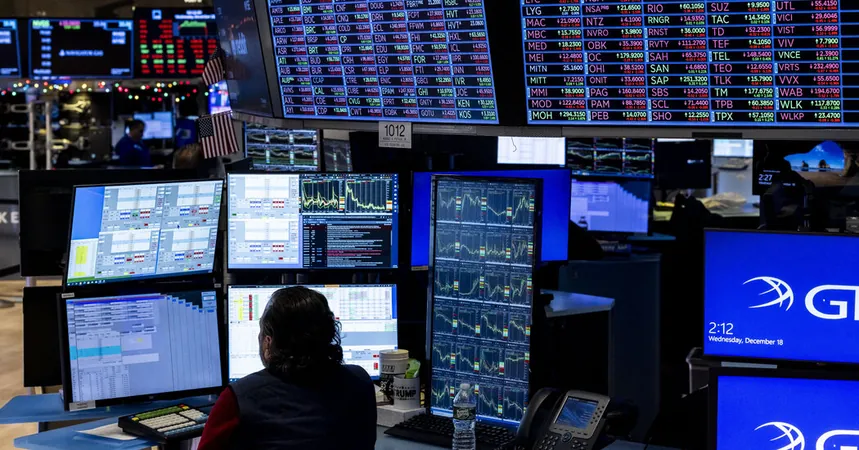
Is the Stock Market Heading for Another Year of Record Gains in 2025?
2024-12-31
Author: Wai
Investor Sentiment and Economic Outlook
As we dive into 2025, investor sentiment appears to be riding high, buoyed by a robust economy and supportive policies from the White House. Analysts are optimistic, forecasting continued growth in the stock market.
Reflecting on 2024's Performance
Reflecting on the previous year, the beginning of 2024 presented a different story. Even the most ardent bulls underestimated the market's strength. The S&P 500 index closed out 2024 with an impressive increase of around 24 percent, mirroring its performance in 2023. This remarkable achievement marks the first time since 1998 that this key benchmark has seen back-to-back annual gains exceeding 20 percent.
Sustaining the Rally into 2025
So, can this rally sustain itself into 2025? The consensus on Wall Street suggests it can. Analysts predict an average rise of approximately 10 percent for the S&P 500 this year, with some like John Stoltzfus, chief investment strategist at Oppenheimer, setting their sights even higher with expectations of a nearly 20 percent uptick.
Economic Resilience and Market Optimism
The road to this financial resilience hasn’t been without obstacles. Following a spike in inflation that prompted the Federal Reserve to aggressively hike interest rates in 2022, many market watchers braced for an impending recession. However, a downturn never materialized. Instead, inflation rates began to cool, and the Fed responded with interest rate cuts in 2024, further bolstering the economy. While consumers continue to navigate the strain of higher prices, this pressure has yet to translate into market declines.
Alan McKnight, chief investment officer at Regions Bank, noted, “Last year, there was a palpable sense of dread about the economy, but it has proven to be incredibly resilient.”
Investment Trends and Tech Sector Performance
In 2024, approximately $500 billion flowed into U.S. stock-focused funds, with a substantial portion arriving in the fourth quarter, following the Fed's initial interest rate cuts. Investors capitalized on this wave of optimism, particularly in the aftermath of the November elections and a critical Fed rate cut in December.
“Markets kept climbing the wall of worry,” McKnight added, highlighting the enduring optimism despite market challenges.
Technology giants like Apple, Microsoft, and Nvidia have continued to power stock indexes, with the frenzy surrounding artificial intelligence fuelling investor enthusiasm. This month, chip maker Broadcom joined the ranks of trillion-dollar companies, demonstrating the weight that these tech behemoths carry in the market.
Meanwhile, the tech-heavy Nasdaq Composite is on pace for a stellar gain of over 30 percent this year, far outpacing smaller company indexes like the Russell 2000, which is expected to rise roughly 10 percent in 2024.
Caution Amid Optimism
Despite the optimistic economic backdrop, analysts remain cautious of looming variables. Concerns about rising unemployment, credit card delinquencies, and potential corporate debt defaults could pose risks. The shift in power with Donald Trump returning to the White House adds to this uncertainty, as investors anticipate his economic policies.
Proposals for tax cuts and deregulation are seen as potential boosters for corporate profits and overall market performance. However, there is apprehension that aggressive tariffs and immigration restrictions could reignite inflation, which may impede interest rate cuts and affect the rally.
Fed's Caution and Market Monitoring
Indeed, the Fed's recent meeting in December signalled caution, as officials chose to cut rates to stabilize the current economic climate rather than speculate on future conditions under Trump's administration. One governor even voted against the consensus rate cut due to worries about inflation reaccelerating in 2025.
Torsten Slok, an economist at Apollo, warned that with stock valuations nearing record highs, investor complacency could become a risk. He noted that inflation has yet to reach the Fed’s target of 2 percent, and emerging policies on tariffs and immigration could increase the potential for a resurgence in inflation.
Looking Ahead to 2025
Should inflation pressures rise, expectations of further rate cuts could diminish, potentially jeopardizing stock market support. Investors are thus closely monitoring the administration's policy direction which could influence the market's trajectory, particularly as Trump outlines his strategy.
As we step into 2025, the big question remains: Will the stock market continue its record ascent, or are there hidden challenges lurking that could derail this optimism? Investors are now more than ever attuned to the developments, eager for clarity on the economic landscape ahead.


 Brasil (PT)
Brasil (PT)
 Canada (EN)
Canada (EN)
 Chile (ES)
Chile (ES)
 España (ES)
España (ES)
 France (FR)
France (FR)
 Hong Kong (EN)
Hong Kong (EN)
 Italia (IT)
Italia (IT)
 日本 (JA)
日本 (JA)
 Magyarország (HU)
Magyarország (HU)
 Norge (NO)
Norge (NO)
 Polska (PL)
Polska (PL)
 Schweiz (DE)
Schweiz (DE)
 Singapore (EN)
Singapore (EN)
 Sverige (SV)
Sverige (SV)
 Suomi (FI)
Suomi (FI)
 Türkiye (TR)
Türkiye (TR)